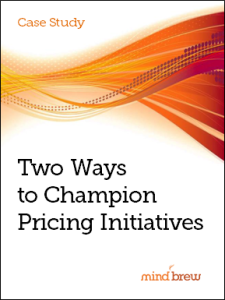If you’ve been following PricingBrew for any length of time at all, you’ve heard us discuss the importance of good price segmentation. And we hear from a lot of pricing people wondering about what makes a segmentation model good. And if you already have a what you think is a good model, how do you make it better?
Of course, the particulars of your products and your market will determine the particulars of your model. However, we have five rules that apply across the board:
- A model with more price segments has more revenue and profit potential. The whole goal of a segmentation model is to get as close as you can to the price your customer is willing to pay. Simple logic dictates that if you have more segments, you’re much more likely to be close to that ideal target. There is a limit (see number four below), but in general, more segments is better.
- It’s about where, when, and why willingness-to-pay is different. Many B2B companies make the mistake of approaching segmentation models backwards; they want to group customers into buckets based on how much they as a vendor want to charge. Yes, your costs to serve particular customers may be higher or lower based on their geographic location or the size of the order, but that doesn’t necessarily correlate with what the customer is willing to pay. To be effective, your model needs to be based on customer willingness to pay, not your desire to charge a certain dollar amount.
- Price segments combine customer, product, and order attributes. A good segmentation model doesn’t ever assign a particular customer, product, or order to a particular bucket all the time. If you have rules like X company always gets charged less or X product always gets commodity-style pricing or orders over a certain size always get a 15% discount, you don’t have a great segmentation model. As circumstances changes, customers and products should be able to move in or out of different segments. For example, perhaps a certain type of company is always price-sensitive — unless they need an order in two days. If you can price according to these changes in circumstances, your profit potential will be much higher.
- You have to balance granularity of the model with your ability to execute. Having the most detailed segmentation model in the world won’t do you a bit of good if your salespeople can’t actually slot deals into that model in a timely manner out in the field. It’s always good to know exactly what different customers might be willing to pay, but you might have to scale back the number of segments in the model you are actually using based on your current processes and technology. However, this is also an opportunity to improve your processes and technology to enable better pricing over time.
- Tribal knowledge is a good start, but using sales data to validate is better. If you have a salesperson who has been with your company for decades, by all means, use that person as a resource as you start to shape your model. That will give the sales team confidence and buy-in as you develop your segments. But you also need to validate that anecdotal evidence with hard data. The data will confirm (or disprove) the sales’ teams beliefs and point you in new directions that they team might not have considered before.
We discuss these laws in more details in the webinar The Fundamentals of Price Segmentation in B2B. You might also want to check out some of our other segmentation resources, like Getting the Most Out of Price Segmentation, Avoiding Three Costly Price Segmentation Mistakes, and How to Explain Price Segmentation to Others.
We’ve said it before, and we will say it again, segmentation is one of the most important aspects of good B2B pricing. And if you want to succeed in pricing, you really need to get your segmentation right.
















